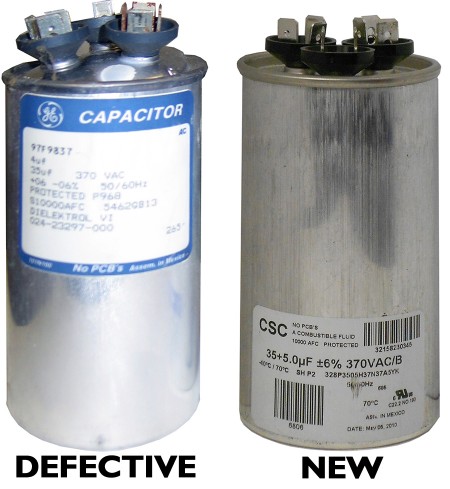In my previous post, I mentioned that I would be doing some pre-season maintenance on my A/C to ensure it’s working at peak efficiency when hot weather arrives. Well, I took my cover off, cleaned-up the cabinet, applied coil cleaner and rinsed. The next couple of days it reached the mid-80s, so I decided to turn the A/C on as it was getting a little uncomfortable inside. Things were going fine until day 2 when I heard a strange noise coming from the unit. It sounded like the condenser was trying to come on, but it wouldn’t turnover. Upon further inspection, I noticed that the compressor seemed to have power, but the fan wasn’t turning.
I quickly realized it was time for action to avoid resting my head on a warm pillow. I gathered my tools, turned the thermostat off, and shut the power off at the outdoor disconnect. After verifying that the fan motor was able to spin freely, I proceeded to remove the access panel to do a visual inspection. There are not a lot of parts on an A/C condenser. You have the main working part, the compressor, a fan motor, run capacitor, and the contactor. Within seconds I noticed that the capacitor was defective as the top of the capacitor was clearly swollen. (See picture) It turned out to be a quick fix, since, as luck would have it, I bought a couple sizes of capacitors to have on hand when a neighbor’s condenser went out last summer. The total time to diagnose and make the repair was less than 20 minutes. My A/C system is approximately 10 years old and this is the first repair I have had to make. It’s not a bad idea to have a capacitor on hand if your system is 5 years old or more. They are inexpensive, easy to replace, and can ensure that your family stays comfortable during the heat and humidity of the summer. This is the collection of our capacitor and replacement parts. Be sure to get all the specifications off of the label of your existing capacitor.

Tips About Run Capacitors: Regardless of the brand of the equipment, these are a generic replacement part as long as they are replaced with a capacitor that has the exact specifications. (Note the specifications on the label) They have two electrical ratings. The first rating is the unit’s capacitance which is given in microfarads (mfd). This is a measure of the amount of charge the unit can store with a specified voltage applied. In the case above, 35 and 5. The second rating is a voltage rating which tells what supply voltage the unit is rated for. This is usually 370VAC or 440VAC in HVAC systems. This is important to know because, if a significantly higher voltage is applied, the capacitor will fail prematurely.
